
Toshiba EMI Odeon and Apple Label
05. Beatles '65 (Beatles For Sale) (OP-7179, OP/AP-8442)
(Update: 17th. April 2020)

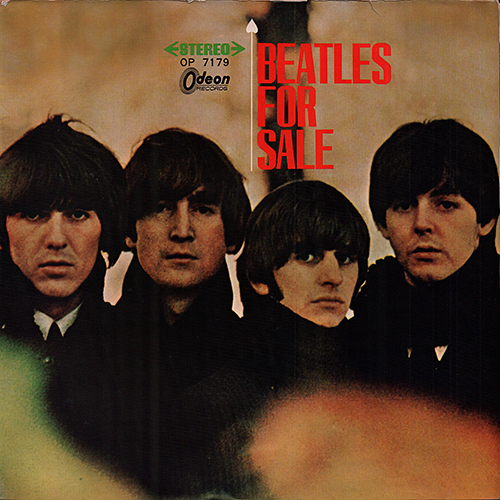 Odeon 1st. Sleeve |
|
|
| TITLE | BEATLES '65
(BEATLES FOR SALE) |
||||
| CATALOG NUMBER | OP-7179 |
||||
| RELEASE DATE | 15th February 1965/First Press |
||||
| TRACK LISTING | SIDE 1 | SIDE 2 | |||
| No Reply |
Eight Days A Week |
||||
| I'm A Loser |
Words Of Love |
||||
| Baby's In Black |
Honey Don't |
||||
| Rock And Roll Music |
Every Little Thing |
||||
| I'll Follow The Sun |
I Don't Want To Spoil The Party |
||||
| Mr. Moonlight |
What You're Doing |
||||
| Kansas City | Everybody's Trying To Be My Baby | ||||
| FRONT --> Click! | BACK --> Click! | SIDE 1 --> Click! | SIDE 2 --> Click! | DISK | |
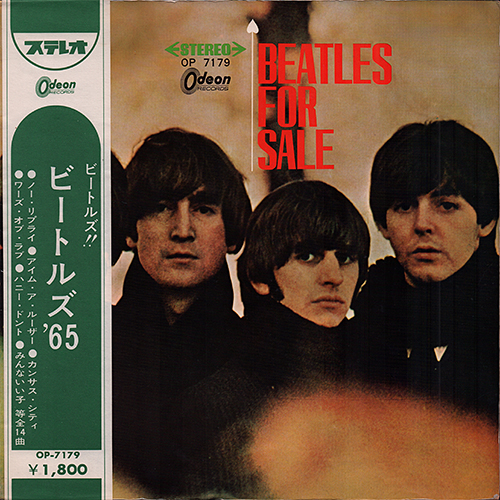 |
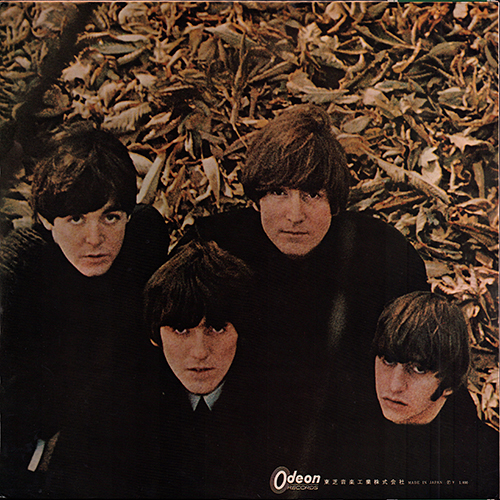 |
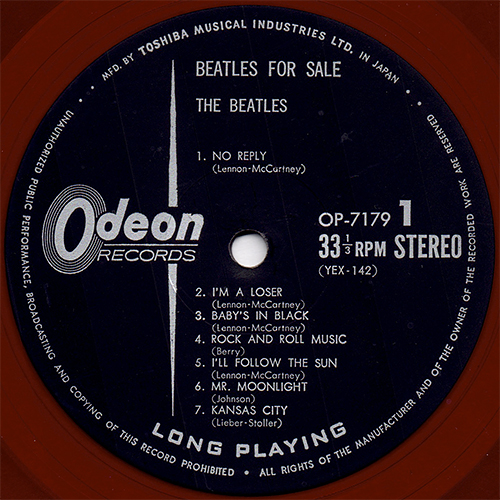 |
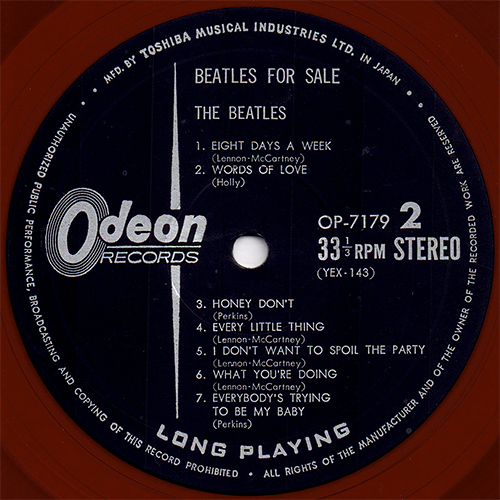 |
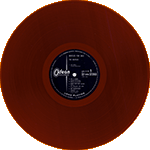 |
|
| INSIDE --> Click! |
LYRIC
SHEET (Slip Sheet Type)
|
||||
| FRONT --> Click! | BACK --> Click! | The lyric sheet is slip sheet type. | |||
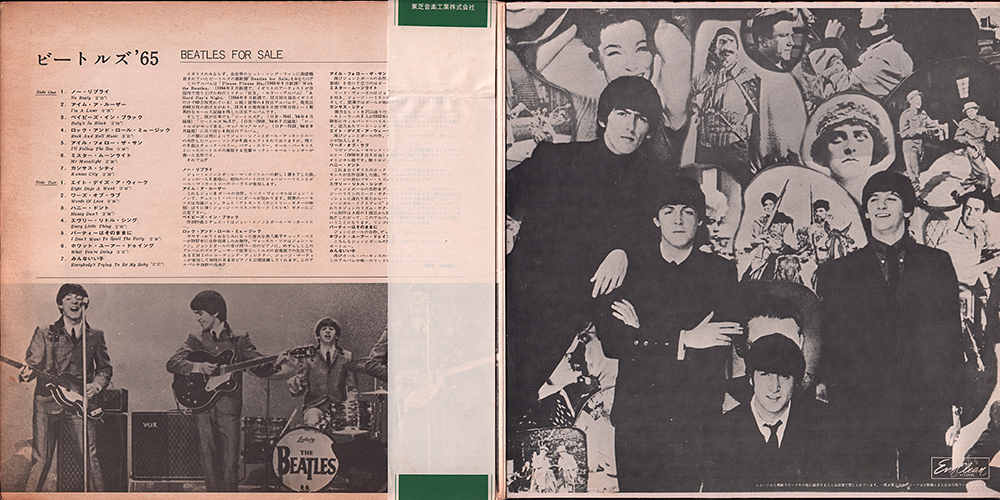 |
 |
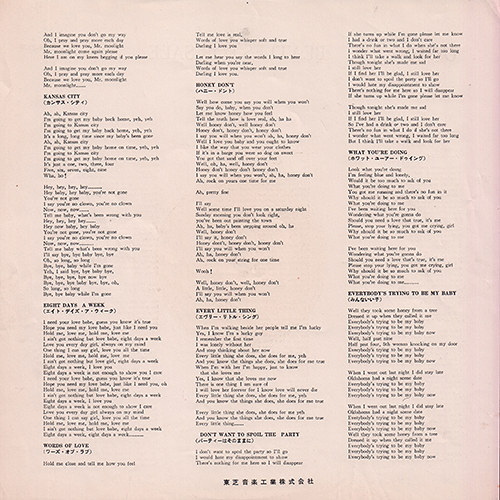 |
|||
| LYRIC SHEET CLOSE UP |
|||||
 |
 |
 |
Catalog number and the company name "Toshiba Musical Industries Ltd." were printed on the lyric sheet. | ||
| LYRIC SHEET CLOSE UP | |||||
 |
Song
title on lyric sheet is misspelled as "(I) DON'T WANT TO SPOIL
THE PARTY" on most (and possibly all) copies. |
||||
| INNER SLEEVE |
INNER SLEEVE CLOSE UP |
||||
| FRONT --> Click! | BACK --> Click! | ||||
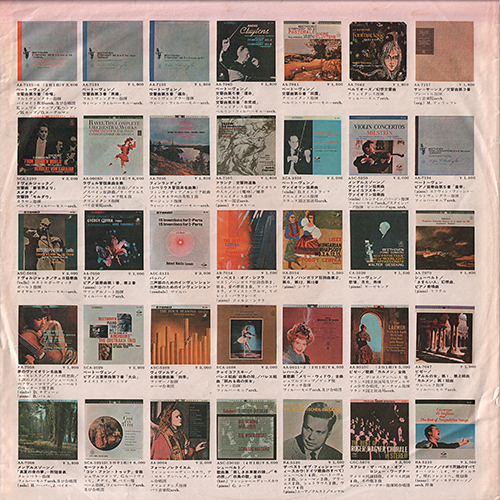 |
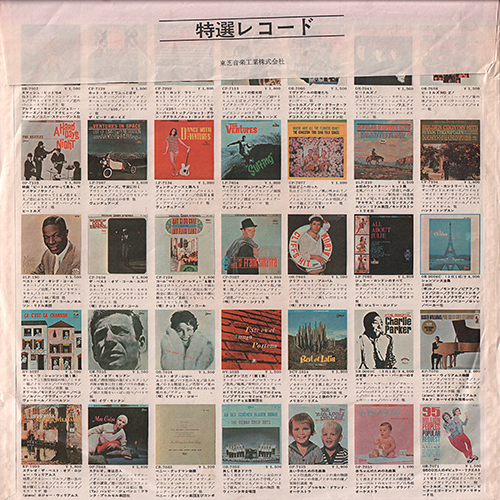 |
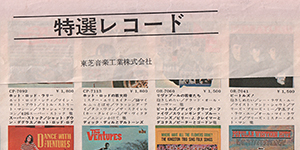 |
The original colour "advert" inner bag has a fold-over flap at the top of the bag to prevent the record from falling out. | ||
|
FRONT
COVER CLOSE UP
|
|||||
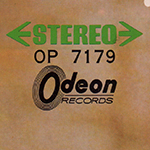 |
The word "STEREO" in
green, catalog number, and Odeon logomark were printed at
the top of the front cover. |
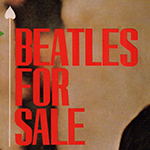 |
The Japanese
version looks similar to the U.K. version but has a
different title design in red on front cover. |
||
| BACK COVER CLOSE UP |
|||||
 |
"Toshiba Musical Industries Ltd." and "F ¥1,800" were printed at the bottom of the back cover. | ||||
| INSIDE CLOSE UP | |||||
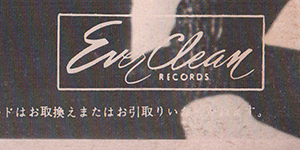 |
 |
||||
| Toshiba pressed a
lot of their records on red, “Everclean” vinyl. The
Everclean vinyl was designed to be less prone to collecting
static electricity and dust than the more common black
vinyl. Japanese original title "Beatles '65" was printed on the inside of the cover. |
|||||
| Dark Green OBI CLOSE UP | |||||
| FRONT TOP |
FRONT TITLE |
FRONT BOTTOM |
BACK |
||
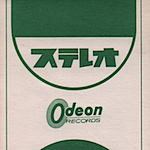 |
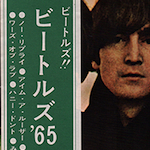 |
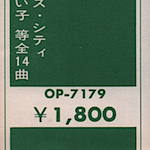 |
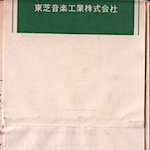 |
Had a dark green / white
OBI and priced ¥1,800 on obi strip. Odeon logo mark and
catalog No. "OP 7179" were printed on the front. There is no order sheet on the back side of the Obi. |
|
| LABEL CLOSE UP | |||||
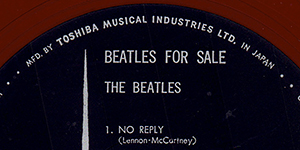 |
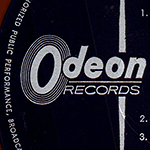 |
Toshiba
pressed a lot of their records on red, "Everclean" vinyl
from 1958 through 1974 (maybe). The Everclean vinyl
was designed to be less prone to collecting static
electricity and dust than the more common black vinyl. The
words "MFD. BY TOSHIBA MUSICAL INDUSTRIES LTD. IN JAPAN" was
printed at the perimeter. |
|||
| LABEL CLOSE UP | |||||
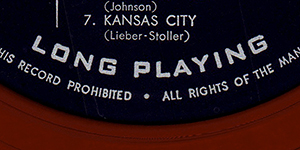 |
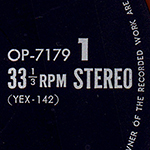 |
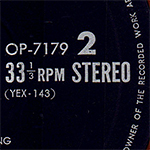 |
The words "LONG PLAYING" was
printed at the bottom of the label. Catalog number and matrix number were printed at the right side of the center hole. |
||
|
OTHER ITEM: POSTCARD
(Campaign Application Postcard)
|
|||||
| CAMPAIGN AD | AD: CLOSE UP | At
the time of this LP release, a campaign was held in which
"The Beatles menber's portrait" won. A campaign application postcard was attached to the first edition (part of?). sorry, I don't have it. |
|||
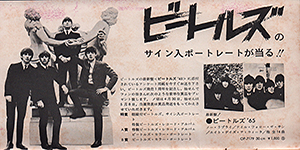
|
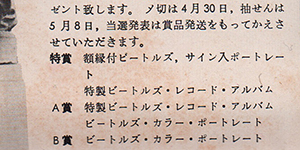 |
||||
| RECORD LABEL | Odeon Label Type-1 (with the words "LONG
PLAYING") |
||||
| MIX | STEREO |
||||
| MATRIX No. | SIDE 1 | YEX-142 21 |
|||
| SIDE 2 | YEX-143
19 |
||||
| PRESS MARK | A5 |
||||
| VINYL COLOR | RED |
||||
| RECORD COMPANY'S NAME | SLEEVE | Toshiba
Ongaku kogyo Kabusikigaisha |
|||
| LABEL | MFD. BY
TOSHIBA MUSICAL INDUSTRIES LTD. IN JAPAN |
||||
| SYMBOL/PRICE | F - ¥1,800 |
||||
| LYRIC SHEET STYLE | Slip Sheet Type |
||||
| COVER FORM | Gatefold type. Full laminated soft cover. |
||||
| INNER SLEEVE |
The original colour "advert" inner bag
Type-1 |
||||
| OBI |
Dark Green Obi with the half circle on top
/ without Order sheet |
||||
| COVER DESIGN/ PHOTO/ NOTES | Photo: Robert Freeman taken in
Hyde Park Liner notes: Yoshiji Kizaki |
||||
|
COMMENTS
|
Black Odeon label with
silver print. The words "LONG PLAYING" was printed at the bottom of the label. Toshiba released the first Japanese record featuring the Beatles. When this record was released, Toshiba's official name was "Toshiba Musical Industries Ltd." and they used the Odeon label for this and subsequent Beatles releases. The Japanese version looks similar to the U.K. version but has a different title design in red on front cover. Japanese original title "Beatles '65" was printed on the obi and the inside of the cover. Gatefold cover to remove the disk from the right side of the back cover. At the time of this LP release, a campaign was held in which "The Beatles menber's portrait" won. A campaign application postcard was attached to the first edition (part of?). Red vinyl: Besides good sound and quality printing, Japanese records also offered some other things of interest to the collector. One of the primary manufacturing companies in Japan, Toshiba, pressed a lot of their records on red, “Everclean” vinyl from 1958 through 1974 (maybe). While not pressed as collectors’ items, these red vinyl pressings are more sought out by collectors than their black vinyl counterparts. The Everclean vinyl was designed to be less prone to collecting static electricity and dust than the more common black vinyl. The obi: "Dark Green" Obi with the half circle on top It is dark green / white in design with dark green background with the half circle on top. It also features an Odeon logo, catalogue number and price information. While most Japanese records feature local music, a lot of music fans there like foreign music, as well. The language barrier in Japan presented a problem – should foreign album covers be changed for Japanese albums? The solution was the obi, which means “belt” or “sash”. The obi is a strip of paper, usually about two inches wide, that wraps vertically around the album cover, containing information about the artist and album in Japanese. As these strips of paper were fragile and easily torn, they are often missing, especially since consumers in the 1950s and 1960s attached little significance to them. Finding Japanese records made prior to 1970 that still have the obi intact can be quite difficult, and for some albums, nearly impossible. The inclusion of the obi can dramatically affect the price of some Japanese records, sometimes increasing the price by a factor of ten. While usually found in a wraparound strip, there are other versions of the obi that have occasionally been used. In the early 1960s, a short-lived hankake obi, or “half obi” was used. These were small strips of paper that simply folded over the top of the cover. These were problematic for retailers, as they tended to easily fall off of the record. |
||||
| TITLE | BEATLES '65
(BEATLES FOR SALE) |
||||
| CATALOG NUMBER | OP-7179 |
||||
| RELEASE DATE | 1965/ Gramophone Contract Press |
||||
| TRACK LISTING | SIDE 1 | SIDE 2 | |||
| No Reply |
Eight Days A Week |
||||
| I'm A Loser |
Words Of Love |
||||
| Baby's In Black |
Honey Don't |
||||
| Rock And Roll Music |
Every Little Thing |
||||
| I'll Follow The Sun |
I Don't Want To Spoil The Party |
||||
| Mr. Moonlight |
What You're Doing |
||||
| Kansas City | Everybody's Trying To Be My Baby | ||||
| FRONT --> Click! | BACK --> Click! | SIDE 1 --> Click! | SIDE 2 --> Click! | DISK | |
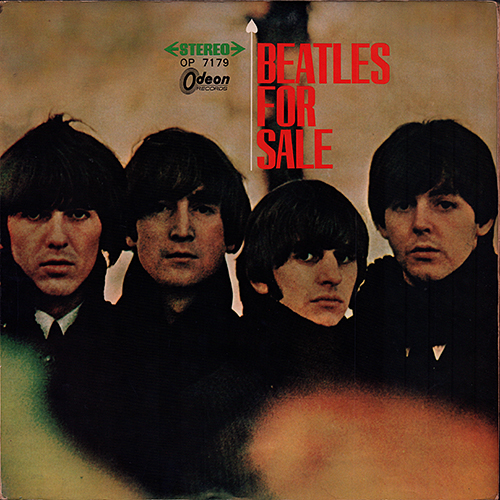 |
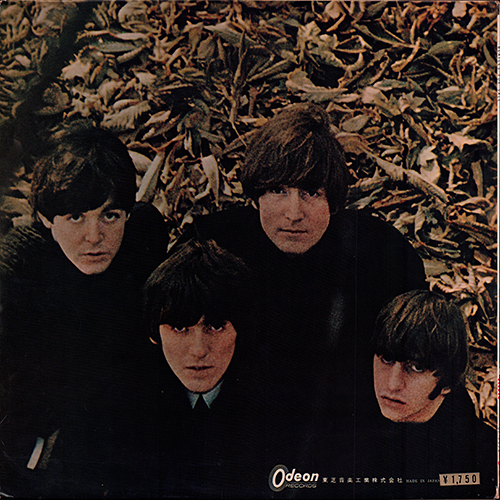 |
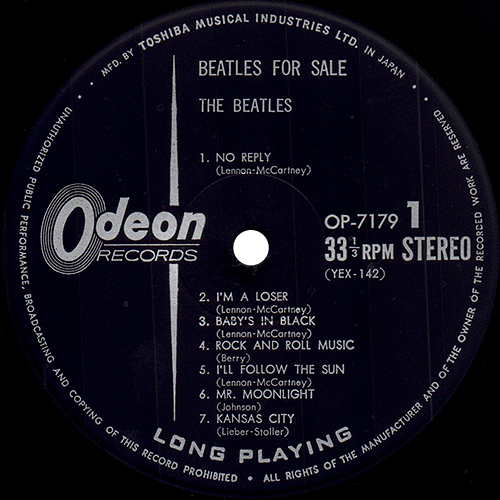 |
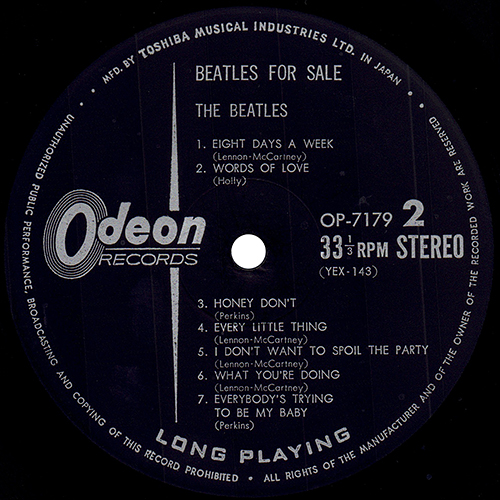 |
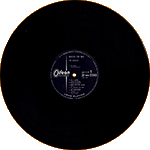 |
|
| INSIDE --> Click! |
LYRIC
SHEET (Slip Sheet Type)
|
||||
| FRONT --> Click! | BACK --> Click! | The lyric sheet is slip sheet type. | |||
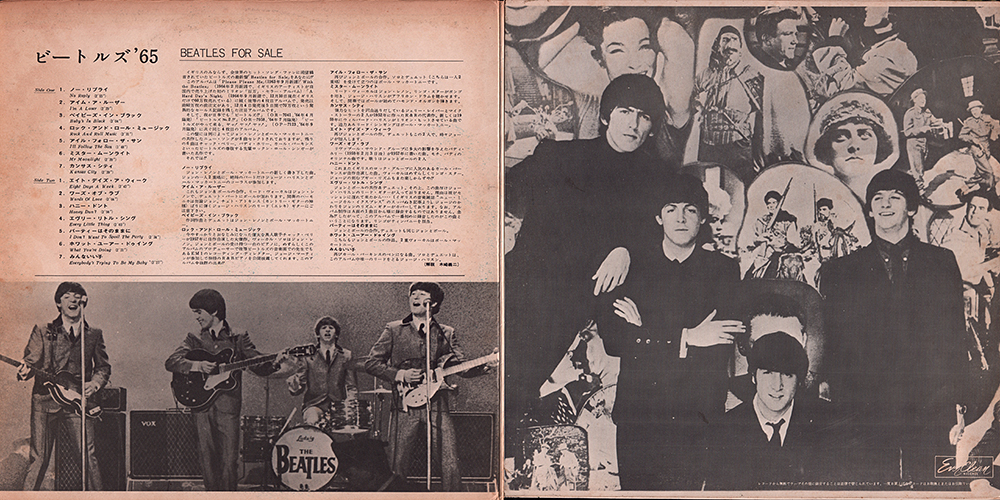 |
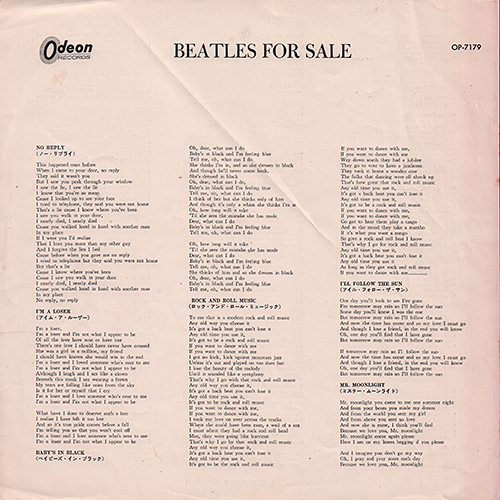 |
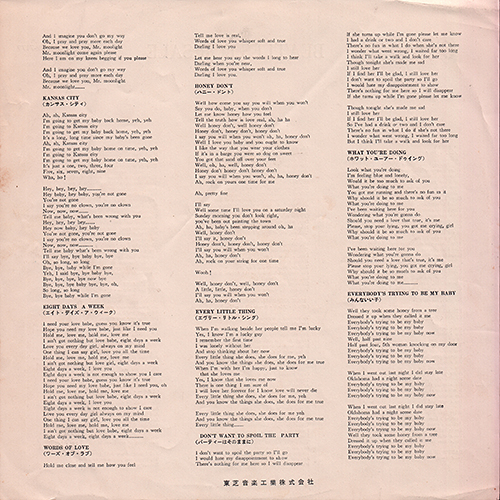 |
|||
| LYRIC SHEET CLOSE UP |
|||||
 |
 |
 |
Catalog number and the company name "Toshiba Musical Industries Ltd." were printed on the lyric sheet. | ||
| LYRIC SHEET CLOSE UP | |||||
 |
Song title on lyric sheet is misspelled as "(I) DON'T WANT TO SPOIL THE PARTY" on most (and possibly all) copies. | ||||
| INNER SLEEVE |
INNER SLEEVE CLOSE UP |
||||
| FRONT --> Click! | BACK --> Click! | ||||
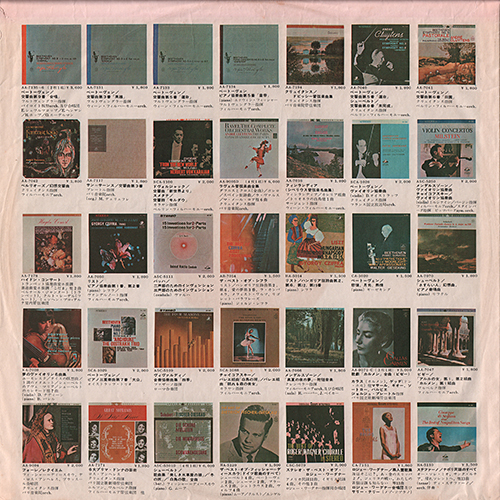 |
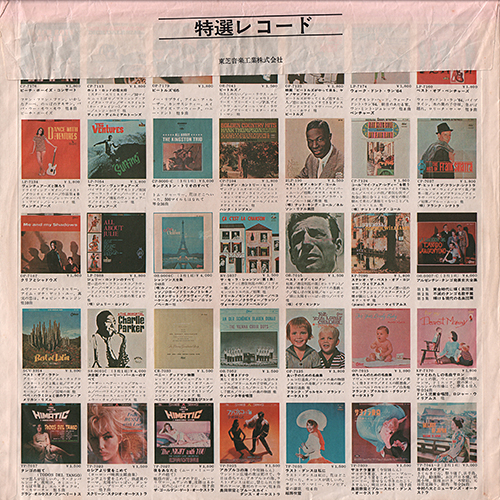 |
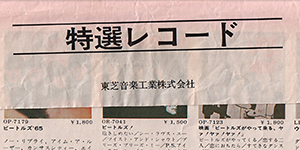 |
The original colour "advert" inner bag has a fold-over flap at the top of the bag to prevent the record from falling out. | ||
|
FRONT
COVER CLOSE UP
|
|||||
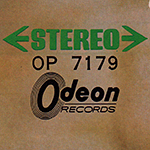 |
The word "STEREO" in
green, catalog number, and Odeon logomark were printed at
the top of the front cover. |
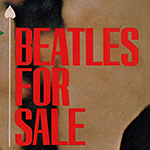 |
The Japanese
version looks similar to the U.K. version but has a
different title design in red on front cover. |
||
| BACK COVER CLOSE UP |
|||||
 |
"Toshiba Musical Industries Ltd." and "F ¥1,800 (pasted on ¥1,750 sticker"" were printed at the bottom of the back cover. | ||||
| INSIDE CLOSE UP | |||||
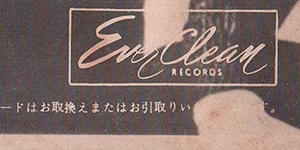 |
 |
||||
 |
Toshiba
pressed a lot of their records on red, “Everclean” vinyl. Japanese original title "Beatles '65" was printed on the inside of the cover. Liner notes: Yoshiji Kizaki |
||||
| Dark Green OBI CLOSE UP | |||||
| Had a dark green / white OBI
and priced ¥1,800 on obi strip. Odeon logo mark and catalog No. "OP 7179" were printed on the front. There is no order sheet on the back side of the Obi. (Sorry, I don't have it.) |
|||||
| LABEL CLOSE UP | |||||
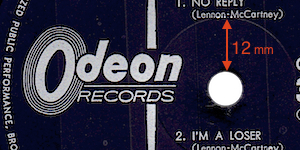 |
 |
Rare Black Vinyl. Sometimes Toshiba had problems to press enough records to keep up with the demand. To increase production they turned to other companies (Gramophone, Sony etc.) to press up some copies of a particular release, however, the majority of copies were pressed by Toshiba themselves. |
|||
| LABEL CLOSE UP | |||||
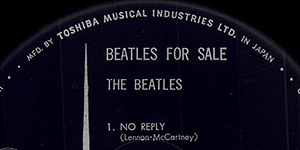 |
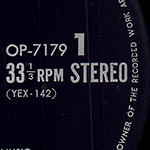 |
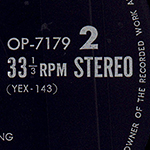 |
The words "MFD. BY TOSHIBA
MUSICAL INDUSTRIES LTD. IN JAPAN" was printed at the
perimeter. Catalog number and matrix number were printed at the right side of the center hole. |
||
| LABEL CLOSE UP | |||||
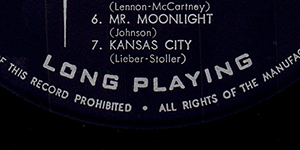 |
The words "LONG PLAYING" was
printed at the bottom of the label. The black vinyl of "Beatles For Sale (OP-7179)" is the oldest Beatles LP in Japan. |
||||
|
OTHER ITEM
|
|||||
| - |
|||||
| RECORD LABEL | Odeon Label Type-1 (with the words "LONG
PLAYING") |
||||
| MIX | STEREO |
||||
| MATRIX No. | SIDE 1 | YEX-142-3 1 |
|||
| SIDE 2 | YEX-143-23
1 |
||||
| PRESS MARK | None |
||||
| VINYL COLOR | BLACK
(Gramophone Contract Press) |
||||
| RECORD COMPANY'S NAME | SLEEVE | Toshiba
Ongaku kogyo Kabusikigaisha |
|||
| LABEL | MFD. BY
TOSHIBA MUSICAL INDUSTRIES LTD. IN JAPAN |
||||
| SYMBOL/PRICE | F - ¥1,800 (pasted on "¥1,750" sticker) |
||||
| LYRIC SHEET STYLE | Slip Sheet Type |
||||
| COVER FORM | Gatefold type. Full laminated soft cover. |
||||
| INNER SLEEVE |
The original colour "advert" inner bag
Type-1 |
||||
| OBI |
Dark Green Obi with the half circle on top
/ without Order sheet (Sorry, I don't have it) |
||||
| COVER DESIGN/ PHOTO/ NOTES | Photo: Robert Freeman taken in
Hyde Park Liner notes: Yoshiji Kizaki |
||||
|
COMMENTS
|
Black Odeon label with
silver print. The words "LONG PLAYING" was printed at the bottom of the label. Rare Black vinyl disc. Most if not all of the red vinyl OR and OP Odeon LPs were manufactured with an ingredient intended to prevent the buildup of static electricity on the disks. TOSHIBA's trademark for records manufactured with this ingredient is "Ever Clean", and special efforts were made to promote this feature. Sometimes Toshiba had problems to press enough records to keep up with the demand. To increase production they turned to other companies (Gramophone, Sony etc.) to press up some copies of a particular release, however, the majority of copies were pressed by Toshiba themselves. The black vinyl of "Beatles For Sale (OP-7179)" is the oldest Beatles LP in Japan. The Japanese version looks similar to the U.K. version but has a different title design in red on front cover. Japanese original title "Beatles '65" was printed on the obi and the inside of the cover. Gatefold cover to remove the disk from the right side of the back cover. Red vinyl: Besides good sound and quality printing, Japanese records also offered some other things of interest to the collector. One of the primary manufacturing companies in Japan, Toshiba, pressed a lot of their records on red, “Everclean” vinyl from 1958 through 1974 (maybe). While not pressed as collectors’ items, these red vinyl pressings are more sought out by collectors than their black vinyl counterparts. The Everclean vinyl was designed to be less prone to collecting static electricity and dust than the more common black vinyl. The obi: "Dark Green" Obi with the half circle on top It is dark green / white in design with dark green background with the half circle on top. It also features an Odeon logo, catalogue number and price information. While most Japanese records feature local music, a lot of music fans there like foreign music, as well. The language barrier in Japan presented a problem – should foreign album covers be changed for Japanese albums? The solution was the obi, which means “belt” or “sash”. The obi is a strip of paper, usually about two inches wide, that wraps vertically around the album cover, containing information about the artist and album in Japanese. As these strips of paper were fragile and easily torn, they are often missing, especially since consumers in the 1950s and 1960s attached little significance to them. Finding Japanese records made prior to 1970 that still have the obi intact can be quite difficult, and for some albums, nearly impossible. The inclusion of the obi can dramatically affect the price of some Japanese records, sometimes increasing the price by a factor of ten. |
||||
| TITLE | BEATLES '65
(BEATLES FOR SALE) |
||||
| CATALOG NUMBER | OP-8442 |
||||
| RELEASE DATE | July 1968 / Third Press |
||||
| TRACK LISTING | SIDE 1 | SIDE 2 | |||
| No Reply |
Eight Days A Week |
||||
| I'm A Loser |
Words Of Love |
||||
| Baby's In Black |
Honey Don't |
||||
| Rock And Roll Music |
Every Little Thing |
||||
| I'll Follow The Sun |
I Don't Want To Spoil The Party |
||||
| Mr. Moonlight |
What You're Doing |
||||
| Kansas City | Everybody's Trying To Be My Baby | ||||
| FRONT --> Click! | BACK --> Click! | SIDE 1 --> Click! | SIDE 2 --> Click! | DISK | |
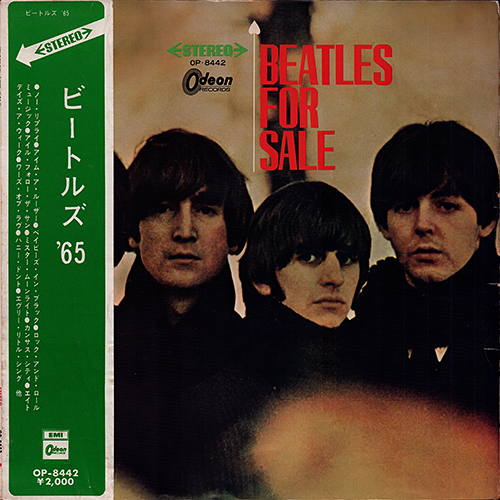 |
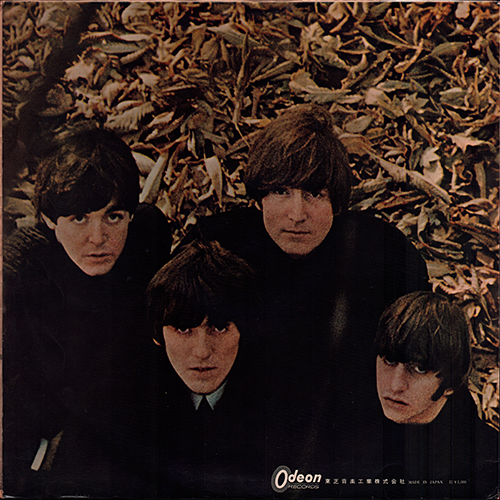 |
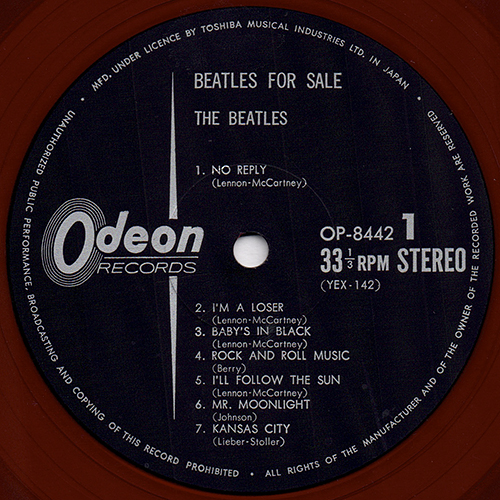 |
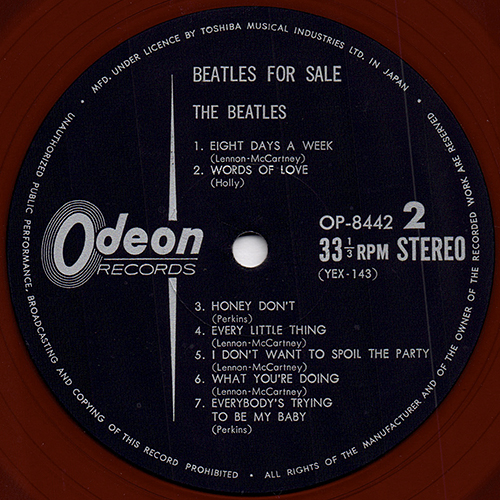 |
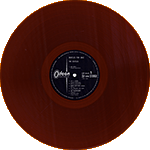 |
|
| INSIDE |
LYRIC
SHEET (Slip Sheet Type)
|
||||
| FRONT --> Click! | BACK --> Click! | The lyric sheet is slip sheet type. | |||
 |
 |
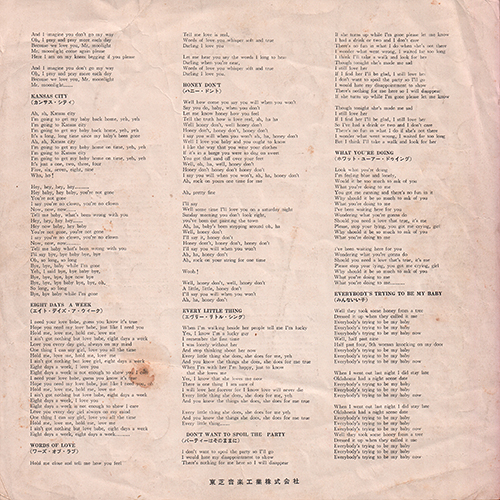 |
|||
| LYRIC SHEET CLOSE UP |
|||||
 |
 |
 |
Catalog number and the company name "Toshiba Musical Industries Ltd." were printed on the lyric sheet. | ||
| INNER SLEEVE |
INNER SLEEVE CLOSE UP |
||||
| FRONT --> Click! | BACK --> Click! | ||||
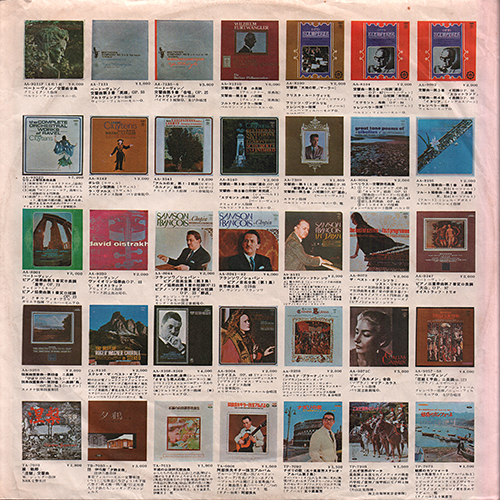 |
 |
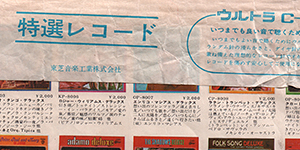 |
The original colour "advert" inner bag has a fold-over flap at the top of the bag to prevent the record from falling out. | ||
|
FRONT
COVER CLOSE UP
|
|||||
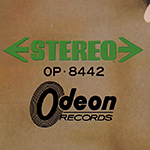 |
The word "STEREO" in
green, catalog number, and Odeon logomark were printed at
the top of the front cover. |
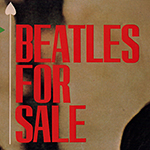 |
The Japanese
version looks similar to the U.K. version but has a
different title design in red on front cover. |
||
| BACK COVER CLOSE UP |
|||||
 |
"Toshiba Musical Industries Ltd." and "F ¥1,800" were printed at the bottom of the back cover. | ||||
| INSIDE CLOSE UP | |||||
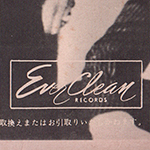 |
Toshiba pressed a lot of their records on red, “Everclean” vinyl. The Everclean vinyl was designed to be less prone to collecting static electricity and dust than the more common black vinyl. |  |
|||
Japanese original title "Beatles '65" was printed on the inside of the cover. |
|||||
| Dark Green OBI CLOSE UP | |||||
| FRONT TOP |
FRONT TITLE |
FRONT BOTTOM |
BACK |
||
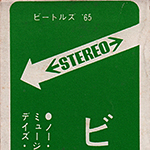 |
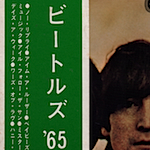 |
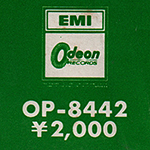 |
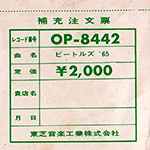 |
3rd. pressing had a green
"arrow" OBI and priced ¥2,000 on obi strip. The word
"STEREO", EMI/Odeon
logo mark and catalog number "OP-8442" were printed
on the front. |
|
| LABEL CLOSE UP | |||||
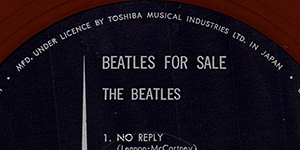 |
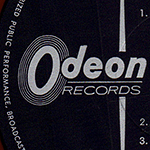 |
The words "MFD. UNDER LICENCE BY
TOSHIBA MUSICAL INDUSTRIES LTD. IN JAPAN" was printed at the
perimeter. |
|||
| LABEL CLOSE UP | |||||
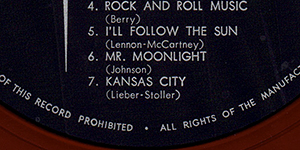 |
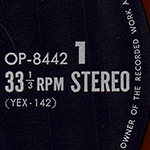 |
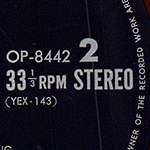 |
Toshiba pressed a lot of
their records on red, "Everclean" vinyl from 1958 through
1974 (maybe). The words "LONG PLAYING" was removed at the bottom of the label. |
||
|
OTHER ITEM
|
|||||
| - |
|||||
| RECORD LABEL | Odeon Label Type-3 ("MFD. UNDER LICENCE BY"
perimeter and without the words "LONG PLAYING") |
||||
| MIX | STEREO |
||||
| MATRIX No. | SIDE 1 | YEX-142-21 4 |
|||
| SIDE 2 | YEX-143-4
3 |
||||
| PRESS MARK | 8G |
||||
| VINYL COLOR | RED |
||||
| RECORD COMPANY'S NAME | SLEEVE | Toshiba
Ongaku kogyo Kabusikigaisha |
|||
| LABEL | MFD. UNDER LICENCE BY TOSHIBA
MUSICAL INDUSTRIES LTD. IN JAPAN |
||||
| SYMBOL/PRICE | H ¥2,000 |
||||
| LYRIC SHEET STYLE | Slip Sheet Type |
||||
| COVER FORM | Gatefold type. Full laminated soft cover. |
||||
| INNER SLEEVE |
The original colour "advert" inner bag
Type-6 |
||||
| OBI |
Green / white so called "Odeon Arrow" OBI |
||||
| COVER DESIGN/ PHOTO/ NOTES | Photo: Robert Freeman taken in
Hyde Park |
||||
|
COMMENTS
|
Black Odeon label with
silver print: The words "LONG PLAYING" was removed at the bottom of the label. Odeon label was changed from type-2 to type-3. The words "MFD. UNDER LICENCE BY TOSHIBA MUSICAL INDUSTRIES LTD. IN JAPAN" was printed at the perimeter. Taking advantage of the rise in LP prices in 1967, the price of a stereo LP rose to 2,000 yen. Already released Beatles LPs have been reissued with the record number changed to OP-8,000, and the obi changed to an arrow obi. The alphabet symbol and price display on the back of the cover have also been changed to "H ¥2,000". The Japanese version looks similar to the U.K. version but has a different title design in red on front cover. Japanese original title "Beatles '65" was printed on the obi and the inside of the cover. Gatefold cover to remove the disk from the right side of the back cover. Red vinyl: Besides good sound and quality printing, Japanese records also offered some other things of interest to the collector. One of the primary manufacturing companies in Japan, Toshiba, pressed a lot of their records on red, “Everclean” vinyl from 1958 through 1974 (maybe). While not pressed as collectors’ items, these red vinyl pressings are more sought out by collectors than their black vinyl counterparts. The Everclean vinyl was designed to be less prone to collecting static electricity and dust than the more common black vinyl. The obi: A. K. A."Arrow" Obi 3rd. pressing had a green / white so called "Arrow" OBI and priced ¥2000 on rear sleeve and obi strip. On June 1967, starting with "Oldies (OP-8016)", numbering for new Odeon LPs changed to the 8000 range numbers. So Obis were renew, A.K.A. Odeon "Arrow Obi" in green and with the same design as the Apple Obis. While most Japanese records feature local music, a lot of music fans there like foreign music, as well. The language barrier in Japan presented a problem – should foreign album covers be changed for Japanese albums? The solution was the obi, which means “belt” or “sash”. The obi is a strip of paper, usually about two inches wide, that wraps vertically around the album cover, containing information about the artist and album in Japanese. As these strips of paper were fragile and easily torn, they are often missing, especially since consumers in the 1950s and 1960s attached little significance to them. Finding Japanese records made prior to 1970 that still have the obi intact can be quite difficult, and for some albums, nearly impossible. The inclusion of the obi can dramatically affect the price of some Japanese records, sometimes increasing the price by a factor of ten. |
||||
|
TITLE
|
BEATLES FOR SALE (Beatles '65) | |||
|
RELEASE DATE
|
August 1968?/3rd. Press | |||
| FRONT --> Click! | BACK --> Click! | SIDE 1 -->Click! | SIDE 2-->Click! | |
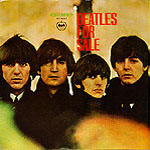 |
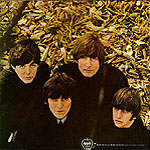 |
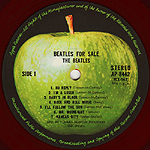 |
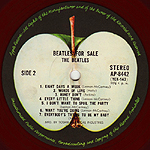 |
|
| INSIDE | INSIDE COVER CLOSE UP | DISK | ||
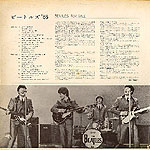 |
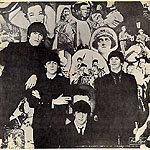 |
 |
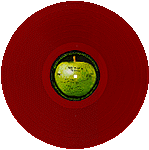 |
|
|
"Toshiba Musical Industries Ltd." and
"H-\2,000" was printed at the bottom of the back cover.
|
||||
| BACK COVER CLOSE UP | LYRIC
SHEET (Slip Sheet type) |
INNER SLEEVE | ||
 |
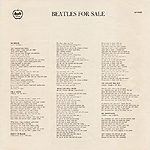 |
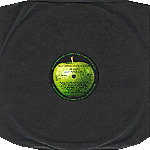 |
||
|
"Toshiba Musical Industries Ltd." and
"H-\2,000" was printed at the bottom of the back cover.
|
||||
|
LABEL CLOSE UP
|
OBI BACK CLOSE UP
|
|||
 |
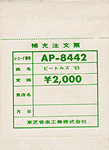 |
|||
|
The words "MFD. BY TOSHIBA MUSICAL
INDUSTRIES LTD. JAPAN" was printed on the label.
|
||||
| TRACK LISTING | CATALOG NUMBER | |||
| SIDE 1 | SIDE 2 | AP-8442 | ||
| No Reply I'm A Loser Baby's In Black Rock And Roll Music I'll Follow The Sun Mr. Moonlight Kansas City |
Eight Days A Week Words Of Love Honey Don't Every Little Thing I Don't Want To Spoil The Party What You're Doing Everybody's Trying To Be My Baby |
|||
| LABEL | ||||
| APPLE type 1 | ||||
| MIX | ||||
| STEREO | ||||
| VINYL COLOR | ||||
| RED | ||||
|
RECORD COMPANY'S
NAME
|
COVER
|
Toshiba Ongakukogyo Kabusikigaisya | ||
|
LABEL
|
MFD. BY TOSHIBA MUSICAL INDUSTRIES LTD. JAPAN |
|||
|
SYMBOL/PRICE
|
H-2,000YEN | |||
|
OBI
|
"Arrow" in dark green Obi with Apple logo / with Order sheet | |||
|
COVER FORM
|
Gatefold/Laminated soft cover | |||
|
COMMENTS
|
Dark Green Apple label: with "TOSHIBA MUSICAL..." credit. |
|||
| TITLE | BEATLES '65
(BEATLES FOR SALE) |
||||
| CATALOG NUMBER | AP-8442 |
||||
| RELEASE DATE | 1972? / 5th. Press |
||||
| TRACK LISTING | SIDE 1 | SIDE 2 | |||
| No Reply |
Eight Days A Week |
||||
| I'm A Loser |
Words Of Love |
||||
| Baby's In Black |
Honey Don't |
||||
| Rock And Roll Music |
Every Little Thing |
||||
| I'll Follow The Sun |
I Don't Want To Spoil The Party |
||||
| Mr. Moonlight |
What You're Doing |
||||
| Kansas City | Everybody's Trying To Be My Baby | ||||
| FRONT --> Click! | BACK --> Click! | SIDE 1 --> Click! | SIDE 2 --> Click! | DISK --> Click! | |
 |
 |
 |
 |
 |
|
| INSIDE --> Click! |
LYRIC
SHEET (Slip Sheet Type)
|
||||
| FRONT --> Click! | BACK --> Click! | The lyric sheet is slip sheet type. | |||
 |
 |
 |
|||
| LYRIC SHEET CLOSE UP |
|||||
 |
 |
 |
Catalog number and the company name "Toshiba Musical Industries Ltd." were printed on the lyric sheet. | ||
| INNER SLEEVE |
FRONT COVER CLOSE UP | ||||
| FRONT --> Click! | BACK --> Click! | ||||
 |
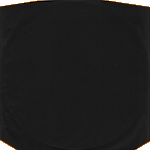 |
 |
 |
The Japanese version looks similar to the U.K. version but has a different title design in red on front cover. | |
| BACK COVER CLOSE UP |
|||||
 |
|||||
| "Toshiba Musical Industries Ltd." and "H ¥2,000" were printed at the bottom of the back cover. | |||||
| INSIDE CLOSE UP | |||||
 |
 |
||||
| "Everclean" vinyl logomark was erased on the cover. Japanese original title "Beatles '65" was printed on the inside of the cover. |
|||||
| Dark Green OBI CLOSE UP | |||||
| FRONT TOP |
FRONT TITLE |
FRONT BOTTOM |
BACK |
||
 |
 |
 |
 |
5th. pressing had a green
"arrow" OBI and priced ¥2,000 on obi strip. The word
"STEREO", Apple logo
mark and catalog number AP-8442" were printed on the front. |
|
| LABEL CLOSE UP | |||||
 |
 |
 |
The phrase "Apple Records - All Rights of
the Manufacturer and of the Owner of the Recorded work
Reserved." was printed at the perimeter. |
||
 |
 |
The words
"MFD. BY TOSHIBA MUSICAL INDUSTRIES LTD. JAPAN" was printed
at the bottom of the label.Catalog No. "AP-8442" and matrix
number were printed at the right side of the center hole. |
|||
| LABEL CLOSE UP | |||||
 |
 |
Song title and composer's
name were printed on the label. |
|||
|
OTHER ITEM
|
|||||
| TRACK LIST SHEET | TRACK LIST SHEET: CLOSE
UP |
||||
| FRONT --> Click! | BACK --> Click! | ||||
 |
 |
 |
|||
 |
With a track list sheet. |
||||
| - |
|||||
| RECORD LABEL | Light Green Apple label Type-2-1 |
||||
| MIX | STEREO |
||||
| MATRIX No. | SIDE 1 | YEX-142
3S 8 |
|||
| SIDE 2 | YEX-143
3S 10 |
||||
| PRESS MARK | 2LW |
||||
| VINYL COLOR | BLACK |
||||
| RECORD COMPANY'S NAME | SLEEVE | Toshiba
Ongaku
kogyo Kabusikigaisha |
|||
| LABEL | MFD. BY
TOSHIBA MUSICAL INDUSTRIES LTD. JAPAN |
||||
| SYMBOL/PRICE | H ¥2,000 |
||||
| LYRIC SHEET STYLE | Slip Sheet Type |
||||
| COVER FORM | Gatefold type. Full laminated soft cover. |
||||
| INNER SLEEVE |
Apple custom black sleeve |
||||
| OBI |
Green / white so called "Odeon Arrow" OBI |
||||
| COVER DESIGN/ PHOTO/ NOTES | Photo: Robert Freeman taken in
Hyde Park |
||||
|
COMMENTS
|
Light green Apple
label Type-2-1 with black print. The words "MFD. BY TOSHIBA MUSICAL INDUSTRIES LTD. JAPAN" was printed at the bottom of the label. In Novemver 1968, that was the date when Apple Corp Ltd. of England and Toshiba came to an agreement on the manufacturing and distribution of the Beatles' records in Japan. As part of that agreement, Toshiba had to reissue on the Apple label all the records previously issued on the Odeon label. The sleeves also had to be altered to desplay the Apple logo. Futher still, all the Odeon catalog number prefixes were changed to ones with Apple prefixes. In most cases, only the prefixes were changed and the catalog numbers were left intanct. Odeon singles, EPs, and LPs with the OR or OP prefixes were changed to Apple singles, EPs, and LPs with the AR or AP prefixes, respectively. But Toshiba did not instantly implement all these changes and did not immediately withdraw all Odeon label records. In fact, the phasing out of the Odeon label products and the phasing in of the Apple label was a lengthy process taking several months at least. The very first record in Japan issued under the Toshiba/Apple contract and bearing the Apple label was "The Beatles double LP (the White Album)", released on 21th. January 1969. And unlike elsewhere in the world, the first single in Japan to bear the Apple label was not "Hey Jude / Revolution" but rather "Ob- La-Di, Ob-La-Da / While My Guitar Gently Weeps", released on 10th. March, 1969. And in the Apple label, there are two subtypes, TOSHIBA MUSIC and TOSHIBA EMI. Further more, the early copies of the APPLE-TOSHIBA MUSIC type have dark Apple on its label, though the late copies have light one. Taking advantage of the rise in LP prices in 1967, the price of a stereo LP rose to 2,000 yen. Already released Beatles LPs have been reissued with the record number changed to OP-8,000, and the obi changed to an arrow obi. The alphabet symbol and price display on the back of the cover have also been changed to "H ¥2,000". The Japanese version looks similar to the U.K. version but has a different title design in red on front cover. Japanese original title "Beatles '65" was printed on the obi and the inside of the cover. Gatefold cover to remove the disk from the right side of the back cover. The obi: A. K. A."Arrow" Obi 5th. pressing had a green / white so called "Arrow" OBI and priced ¥2,000 on rear sleeve and obi strip. On June 1967, starting with "Oldies (OP-8016)", numbering for new Odeon LPs changed to the 8000 range numbers. So Obis were renew, A.K.A. Odeon "Arrow Obi" in green and with the same design as the Apple Obis. While most Japanese records feature local music, a lot of music fans there like foreign music, as well. The language barrier in Japan presented a problem – should foreign album covers be changed for Japanese albums? The solution was the obi, which means “belt” or “sash”. The obi is a strip of paper, usually about two inches wide, that wraps vertically around the album cover, containing information about the artist and album in Japanese. As these strips of paper were fragile and easily torn, they are often missing, especially since consumers in the 1950s and 1960s attached little significance to them. Finding Japanese records made prior to 1970 that still have the obi intact can be quite difficult, and for some albums, nearly impossible. The inclusion of the obi can dramatically affect the price of some Japanese records, sometimes increasing the price by a factor of ten. |
||||
